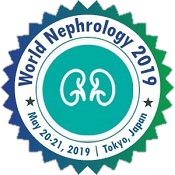
Boris Ajdinović
Military Medical Academy, Serbia
Title: Technetium 99M – dimercaptosuccinic Acid Renal Scintigrafy in Children with Antenatal hydronephrosis
Biography
Biography: Boris Ajdinović
Abstract
Objective.The purpose of this study was to evaluate damage of the kidney with Tc99m-DMSA scintigraphy in children with antenatal hydronephrosis (ANH) and the influence of other postnatal associated diagnoses on abnormal DMSA findings. Subjects and Methods. DMSA scintigraphy in 54 children (17 girls and 37 boys), aged from 2 months to 5 years ( median 11 months) with 66 antenatally detected hydronephrotic renal units (RU) ( 42 unilateral hydronephrosis – 29 boys and 13 girls; 12 bilateral hydronephrosis – 8 boys and 4 girls) was done. Male/female ratio was 2,2: 1, unilateral/bilateral hydronephrosis ratio was 4:1 Hydronephrosis classified into three groups according to ultrasound measurement of the antero-posterior pelvic diameter APD) : mild (APD 5–9.9 mm) was present in 13/66 RU, moderate (APD 10–14.9mm) in 25/66 RU, and severe (APD ≥ 15 mm) in 28/66 RU. Simple hydronephrosis was present in 15 RU, and he postnatal associated clinical diagnosis were vesicoureteric reflux (VUR) in 21, pelviureteric junction (PUJ) obstruction in 7, pyelon et ureter duplex in 11, megaureter in 11 and posterior urethra valves in 1 RU respectively. Static renal scintigraphy was performed 2 to 3 hours after intravenous (iv) injection of 99mTechnetium labeled dimercaptosuccinic acid (DMSA) using a dose of 50 μCi (1.85 MBq/kg; minimal dose: 300 μCi). Four views (posterior, left and right posterior oblique and anterior) were obtained with a single head gamma camera “Orbiter” filtered with high resolution parallel whole collimator. All images were stored in an Pegasys computer with a matrix size of 256 × 256. The relative kidney uptake (RKU) between the left and right kidney was calculated as an average number counts from anterior and posterior view. Renal pathology was defined as inhomogenous or focal/multifocal uptake defects of radiofarmaceutical in hydronephrotic kidney or as split renal uptake of < 40%, and poor kidney function was defined as split renaluptake <10%. Descriptive and analytical statistics (SPSS version 20.0) was performed. Analytical statistics implied the non-parametric Mann-Whitney test for determination of statistically significant difference between the normal and pathological findings on DMSA scan. The default level of significance was p<0.05. Results and Conclusions. DMSA scintigraphy findings in children with ANH were: decreased or enlarged kidney with inhomogeneous kidney uptake radiopharmaceutical in 22, irregular shape kidney with inhomogeneous accumulation of radiopharmaceutical in 3, connected ( fused) kidney in 1 patient, and poorly or nonvisual kidney in 14 RU respectively (total 40/66 renal units with pathlogical DMSA finding, 60,6%)Relative accumulation in hydronephrotic kidney was less or equal to 40% in 17 renal units, less than 10 in 14 renal units. Inhomogeneous radiopharmateutical uptake with relative accumulation over 40% was detected in 9 RU. Regular kidney morphology with homogeneous accumulation of radiopharmateutical (normal DMSA scintigraphy finding) were found in 26/66 renal units (39,4%). Statistically significant correlation between the degree of the hydronephrosis (APD) and DMSA scan finding (p<0.001) and between the degree of the VUR and DMSA scan finding (p=0.002) was established. In our study, other associated diagnosis were not statistically correlated with pathological findings on DMSA scan. On the basis of these results we recommend DMSA scintigraphy in the evaluation renal pathology in children with ANH. Greater number of patients is needed for the estimation of the associated diagnosis (other than VUR) influence on the renal parenchymal damage in children with ANH.

